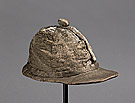Georges BRAQUE

Georges Braque (b Argenteuil-sur-Seine, Seine-et-Oise, France, 13 May 1882 – d Paris, 31 August 1963) studied at night-school at the Ecole des Beaux-Arts in Le Havre and later in Paris in 1900. Influenced by Impressionism, Neo-Impressionism and Fauvism, Braque later focused on his own explorations of geometric forms and space. Another important interest throughout Braque’s career was ancient Greek and Etruscan art.
Braque collaborated with his friend Pablo Picasso to forge the new style of Cubism in 1909, developing it through four stages: Cézannesque, analytic, hermetic and synthetic. Braque passed through these four stages and then began to drift away from the movement. Mobilised for the First World War, he suffered a serious head injury that caused the loss of his sight for a significant period, preventing him from painting again until 1917. By 1920 Braque had become interested in neoclassical aesthetics and by the 1930s his style had totally changed.
In 1923 Braque received his first commission from Diaghilev to produce set designs for the Ballets Russes production of Les Fâcheux (The bores). He collaborated with the Ballets Russes again in 1925 for the production of Zéphyre et Flore and in 1926 for Les Sylphides. As well as his work with the Ballets Russes, Braque designed scenery and costumes for Darius Milhaud’s Salade, which was choreographed by Léonide Massine and performed at the Théâtre de la Cigale in Paris in 1924. In 1950 he designed for Louis Jouvet’s production of Molière’s play Tartuffe at the Théâtre de l’Athénée in Paris.
Man Ray
Georges Braque 1922 Man Ray Trust © Man Ray Trust/ADAGP. Licensed by Viscopy, 2010/Telimage, 2010




